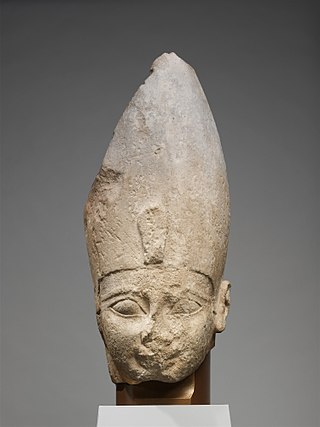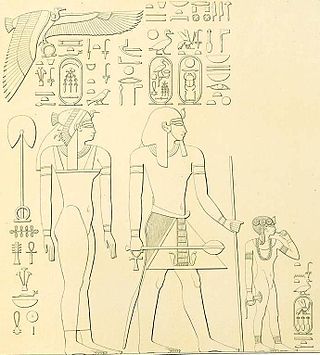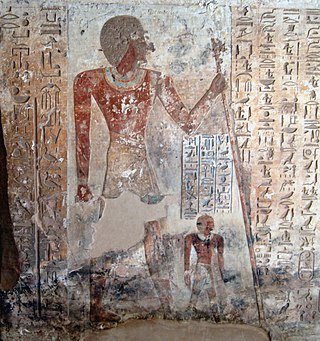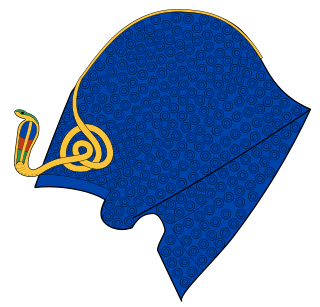
Abydos is one of the oldest cities of ancient Egypt, and also of the eighth nome in Upper Egypt. It is located about 11 kilometres west of the Nile at latitude 26° 10' N, near the modern Egyptian towns of El Araba El Madfuna and El Balyana. In the ancient Egyptian language, the city was called Abdju. The English name Abydos comes from the Greek Ἄβυδος, a name borrowed by Greek geographers from the unrelated city of Abydos on the Hellespont.

Pharaoh is the vernacular term often used for the monarchs of ancient Egypt, who ruled from the First Dynasty until the annexation of Egypt by the Roman Empire in 30 BC. However, regardless of gender, "king" was the term used most frequently by the ancient Egyptians for their monarchs through the middle of the Eighteenth Dynasty during the New Kingdom. The earliest confirmed instances of "pharaoh" used contemporaneously for a ruler were a letter to Akhenaten or an inscription possibly referring to Thutmose III.

Ahmose I was a pharaoh and founder of the Eighteenth Dynasty of Egypt, classified as the first dynasty of the New Kingdom of Egypt, the era in which ancient Egypt achieved the peak of its power. He was a member of the Theban royal house, the son of pharaoh Seqenenre Tao and brother of the last pharaoh of the Seventeenth dynasty, Kamose. During the reign of his father or grandfather, Thebes rebelled against the Hyksos, the rulers of Lower Egypt. When he was seven years old, his father was killed, and he was about ten when his brother died of unknown causes after reigning only three years. Ahmose I assumed the throne after the death of his brother, and upon coronation became known as Nebpehtyre, nb-pḥtj-rꜥ "The Lord of Strength is Ra".

A necklace is an article of jewellery that is worn around the neck. Necklaces may have been one of the earliest types of adornment worn by humans. They often serve ceremonial, religious, magical, or funerary purposes and are also used as symbols of wealth and status, given that they are commonly made of precious metals and stones.

Ahmose was an Ancient Egyptian queen in the Eighteenth Dynasty. She was the Great Royal Wife of the dynasty's third pharaoh, Thutmose I, and the mother of the queen and pharaoh Hatshepsut. Her name means "Born of the Moon".

Amenhotep I, Amenôthes I, or Amenophis I, additionally King Djeserkare, was the second Pharaoh of the 18th Dynasty of Egypt. His reign is generally dated from 1526 to 1506 BC.

Ahmose, son of Ebana, served in the Egyptian military under the pharaohs Ahmose I, Amenhotep I, and Thutmose I. His autobiography has survived and is intact on the wall of his tomb and has proven a valuable source of information on the late 17th Dynasty and the early 18th Dynasty of Egypt.

The New Kingdom, also referred to as the Egyptian Empire, is the period in ancient Egyptian history between the sixteenth century BC and the eleventh century BC, covering the Eighteenth, Nineteenth, and Twentieth dynasties of Egypt. Radiocarbon dating places the beginning of the New Kingdom between 1570 BC and 1544 BC. The New Kingdom followed the Second Intermediate Period and was succeeded by the Third Intermediate Period. It was Egypt's most prosperous time and marked the peak of its power.

Kamose was the last Pharaoh of the Theban Seventeenth Dynasty. He was possibly the son of Seqenenre Tao and Ahhotep I and the brother of Ahmose I, founder of the Eighteenth Dynasty. His reign fell at the very end of the Second Intermediate Period. Kamose is usually ascribed a reign of three years, although some scholars now favor giving him a longer reign of approximately five years.

Ahmose-Nefertari was the first Great Royal Wife of the 18th Dynasty of Ancient Egypt. She was a daughter of Seqenenre Tao and Ahhotep I, and royal sister and wife to Ahmose I. Her son Amenhotep I became pharaoh and she may have served as his regent when he was young. Ahmose-Nefertari was deified after her death.

Seqenenre Tao ruled over the last of the local kingdoms of the Theban region of Egypt in the Seventeenth Dynasty during the Second Intermediate Period. He probably was the son and successor to Senakhtenre Ahmose and Queen Tetisheri. The dates of his reign are uncertain, but he may have risen to power in the decade ending in 1560 BC or in 1558 BC. With his queen, Ahhotep I, Seqenenre Tao fathered two pharaohs, Kamose, his immediate successor who was the last pharaoh of the Seventeenth Dynasty, and Ahmose I who, following a regency by his mother, was the first pharaoh of the Eighteenth. Seqenenre Tao is credited with starting the opening moves in a war of revanchism against Hyksos incursions into Egypt, which saw the country completely liberated during the reign of his son Ahmose I.

Senakhtenre Ahmose, was a king of the Seventeenth Dynasty of Egypt during the Second Intermediate Period. Senakhtenre reigned for a short period over the Theban region in Upper Egypt at a time where the Hyksos 15th Dynasty ruled Lower Egypt. Senakhtenre died c.1560 or 1558 BC at the latest.

Ahmose-Meritamun was a Queen of Egypt during the early Eighteenth Dynasty. She was both the older sister and the wife of Pharaoh Amenhotep I. She died fairly young and was buried in tomb TT358 in Deir el-Bahari.

The khepresh (ḫprš) was an ancient Egyptian royal headdress. It is also known as the blue crown or war crown. New Kingdom pharaohs are often depicted wearing it in battle, but it was also frequently worn in ceremonies. While it was once called the war crown by many, modern historians refrain from characterizing it thus.
Mutnofret, also rendered as Mutneferet or Mutnefert, was a queen during the Eighteenth Dynasty of Egypt. She was a secondary wife of Thutmose I and the mother of his successor Thutmose II; Thutmose I's chief wife, however, was his sister Queen Ahmose, the mother of Hatshepsut.

TT8 is the funerary chapel and tomb of the ancient Egyptian foreman Kha and his wife, Merit. They are known for their undisturbed tomb discovered in 1906 which is considered the best preserved non-royal burial in Egypt. Kha was an "overseer of works" at Deir el-Medina in the mid-Eighteenth Dynasty, where he was responsible for royal tombs constructed in the reigns of pharaohs Amenhotep II, Thutmose IV and Amenhotep III. Of unknown background, he rose to his position through skill and was ultimately rewarded for his work by at least one king. He and his wife Merit had three known children, one of whom also worked in the royal necropolis. Kha died in his 50s or 60s, while Merit died before him, seemingly unexpectedly, in her 30s.

Menhet, Menwi and Merti, also spelled Manhata, Manuwai and Maruta, were three minor foreign-born wives of Pharaoh Thutmose III of the Eighteenth Dynasty. They are known for their lavishly furnished rock-cut tomb in Wady Gabbanat el-Qurud near Luxor, Egypt. They are suggested to be Syrian, as the names all fit into Canaanite name forms, although their ultimate origin is unknown. A West Semitic origin is likely, but both West Semitic and Hurrian derivations have been suggested for Menwi. Each of the wives bear the title of "king's wife", and were likely only minor members of the royal harem. It is not known if the women were related as the faces on the lids of their canopic jars are all different.

As early as the Old Kingdom, Egyptian artisans fashioned images of deities, kings, and mortals wearing broad collars made of molded tubular and teardrop beads. The Usekh or Wesekh is a personal ornament, a type of broad collar or necklace, familiar to many because of its presence in images of the ancient Egyptian elite. Deities, women, and men were depicted wearing this jewelry. One example can be seen on the famous gold mask of Tutankhamun. The ancient word wsẖ can mean "breadth" or "width" in the Ancient Egyptian language and so this adornment is often referred to as the broad collar.

The Eighteenth Dynasty of Egypt is classified as the first dynasty of the New Kingdom of Egypt, the era in which ancient Egypt achieved the peak of its power. The Eighteenth Dynasty spanned the period from 1550/1549 to 1292 BC. This dynasty is also known as the Thutmosid Dynasty for the four pharaohs named Thutmose.

Ancient Egyptian clothes refers to clothing worn in ancient Egypt from the end of the Neolithic period to the collapse of the Ptolemaic Kingdom with the death of Cleopatra in 30 BC. Egyptian clothing was filled with a variety of colors. Adorned with precious gems and jewels, the fashions of the ancient Egyptians were made for not only beauty but also comfort. Egyptian fashion was created to keep cool while in the hot desert.


















